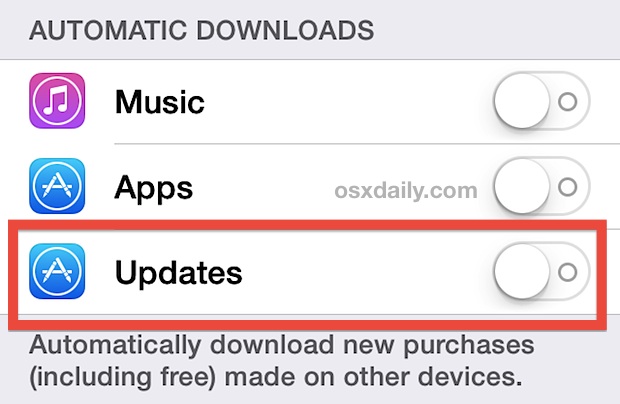How to Turn Off Automatic App Updates in iOS

Automatic Updates is a feature that came along with modern iOS versions which allows updates to installed apps to download and install themselves, allowing for a very hands-off approach to the app updating process on an iPhone or iPad.
For many users this is a good thing to leave on, since it takes the hassle out of updating and managing your apps, and you’ll only have to use the App Store to download new apps instead.
But automatic updates are not always a desirable feature for all users for a variety of reasons, whether you’re trying to squeezes maximum performance out of a device, reduce overall network bandwidth used by an iPhone or iPad, or perhaps you’d just prefer to control the app updating process yourself.
If you’d rather have apps not update themselves in the background, you can take a moment to turn the feature off in iOS.
How to Stop Apps Updating Themselves Automatically in iOS
This works the same in all versions of iOS beyond 7.0, here’s how you can adjust the setting:
- Open Settings and go to “iTunes & App Store”
- Scroll down to the “Automatic Downloads” section
- Toggle “Updates” to OFF to stop apps automatically updating

That’s it, no more automatic app updates, no more surprises when opening apps to find things have changed. Remember, with this feature turned OFF you will need to use the App Store to handle updates yourself, similar to how it was done in the past with all iOS releases pre-7.0.
Turning off Automatic Updates has a few additional side benefits too; it can help increase battery life, and it can also help to speed up iOS 7 equipped devices a bit, particularly older models. Both benefits are a result of reducing background activity and resource usage, and though the newest model iPhone and iPad devices may not notice them quite so much, they can still offer a nice increase to performance all around.
Use Automatic Updates from Wi-Fi Only
If you’d prefer to leave automatic updating on for wi-fi only while preventing it from happening over a cellular data connection, you can do that too with a simple adjustment within the “iTunes & App Store” settings: simply keep Automatic Downloads “Updates” toggled to ON, but toggle “Use Cellular Data” to OFF. Unless you have an unlimited cellular data plan with your iPhone or iPad, it’s probably a good idea to keep cellular data updating completely off. You can make similar precise adjustments to apps data usage habits within the Cellular Data Usage Settings.
Will this Stop the Random Blue Dots Next to App Names?
Yes, this will stop the blue dot from randomly appearing next to app names on your iOS home screen. For those who weren’t aware, the blue dot is an indicator that an app has been updated, or that an app is new to the device, but it has also caused a ton of confusion for many users who wonder why on earth a mysterious blue dot seems to show up alongside app names for seemingly no apparent reason.

Turning off automatic updates will prevent it from showing up at random, and instead the blue dot will only appear when you have updated an app yourself, or downloaded something new from the App Store. You can not disable the blue dot completely.


Most folks think Automatic App Updates will happen over cellular if “Use Cellular Data” is enabled (as that’s what the UI and wording in Settings seems to imply) and then they decide to leave Automatic App Updates off (or block the iTunes Store app from using cellular data entirely, leaving it a “WiFi Only app.”)
Well, I’ve done some testing with WiFi off, and have corroborated the same findings with friends who have done the same. I am confident now to share the conclusion: Automatic App Updates do *not* happen over cellular data, even with “Use Cellular Data” turned on. Automatic App Updates only occur over WiFi. This is good news, and I’m surprised it hasn’t been shared more widely.